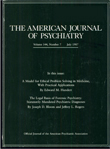The title of this interesting book is something of a misnomer because it does not especially address what most forensic readers would think of as emerging issues. Perhaps a better and more accurate title would be A Forensic Sampler of Issues That Emerged From the Center for Forensic Psychiatry. Dr. Benedek, one of America's leading forensic psychiatrists, is director of the Center, which is an agency of the Michigan Department of Mental Health. She describes the purpose of the Center as follows:
To provide diagnostic and consultative services to the criminal justice system including the bench and bar, to provide state-of-the-art psychiatric treatment to men and women who have a mental disorder or emotional condition that prevents their being adjudicated in the criminal justice system, to provide psychiatric treatment to individuals after adjudication by the criminal justice system, and to provide psychiatric treatment for individuals in the Department of Corrections who are in need of specialized and intensive care. (p. 1)
This somewhat extensive quote is justified in this review because the forensic sampler presented in the chapters of this book emerges from different aspects of the Center's functioning. The book is a mix of very basic issues—testifying in court, forensic child and adolescent psychiatry, training and education, and issues for women in the field—together with very specialized topics such as insanity in filicide and criminal responsibility and solvent exposure. In addition, some materials are simple depictions of activities of the Center, such as a chapter on workplace violence in a psychiatric facility (i.e., the Center) and a description of the Center's evaluation unit services. Because of the level of depth and interest, as well as the broad relevance of their focus, the chapters are more than advertisements for the Center.
The book consists of a series of short, pithy chapters, but it is difficult to imagine for whom it is written. A prospective forensic fellow could quickly grasp the advantages of participation in the Center; indeed, this may be a secondary goal of these presentations. At the same time, certain chapters and certain points made here would be valuable to cite in larger discussions of some of the areas described.
Chapter 1, on testifying in court, is a good summary of this issue with a brief history of the role of forensic psychiatry in relation to the courtroom. The author occasionally throws in terms (e.g., voir dire) without any specific explanation. In addition, although the main focus is on the courtroom, the chapter scants the critical role of preparation of the expert in going into the courtroom, and this hurts the completeness of the chapter. However, many useful points, although somewhat scattered, are made in a short space. For example, the discussion of the ethics of the expert role lies cheek by jowl with the specific mannerisms to use when testifying. This arbitrary juxtaposition makes the chapter less cohesive than it might otherwise be.
The second chapter, on forensic child and adolescent psychiatry, is extremely concise, practical, and filled with pointers and caveats, including a very concise review of landmark cases relating to children. Chapter 3, “Insanity and Filicide: Women Who Murder Their Children,” is a thoughtful study with an interesting case history. Chapter 4, on security and patient management, is a report from the trenches on the difficulties of managing a security hospital while attempting to preserve a therapeutic environment. It presents a valuable schema and describes the author's own considerable practical experience as a security administrator.
Chapter 5, “Challenges for Women in Forensic Psychiatry,” is quite far-ranging and yet remarkably concise; indeed, conciseness is one of the virtues of all of these chapters. Chapter 6 describes a curriculum for psychologists in forensic psychiatry organized around five critical learning objectives. Although basic, this is detailed and practical and, therefore, valuable to scholars in this area. The claim of excessive solvent sniffing as an argument for criminal nonresponsibility (chapter 7) is an interesting and unusual case description addressing appropriate forensic challenges to the validity of this claim.
Chapter 8, on workplace violence, has a novel twist. One expects the violence in a forensic setting to flow from the inmates, but here is a discussion of the danger to staff from staff. A questionnaire study is used to review actual threats or assaults by employees on other employees and the perception of safety. The author's conclusions include that threats and assaults are underreported and that, based on staff members' perception of their safety, the level of risk is generally underestimated.
Chapter 9, on training and education, is very much a first-person discussion that reviews the requirements to sit for the forensic boards and the elements of accreditation in a forensic fellowship. It closes with some personal reflections about the author's experience of going into forensic psychiatry. Since the Center is one of the handful of accredited programs currently in existence, this chapter is perhaps guilty of an “advertising” role. The final chapter gives detailed descriptions of the evaluation unit at the Center, a specialized outpatient service that performs useful evaluations.
In sum, it is clear that this book's strengths are its interesting variety (the sampler effect) of subjects discussed in concise and thus highly readable form. A forensic fellow early in training would find this extremely valuable and a valid and validated advertisement for the Center. It would be useful for general forensic readers to consult, should similar cases arise in their caseloads.

